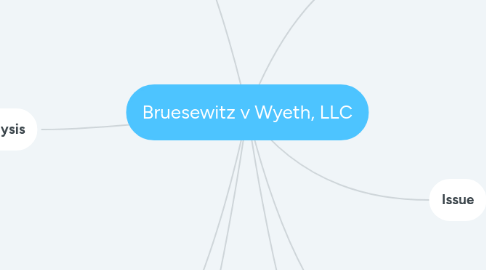
1. Facts
1.1. Defendant: Wyeth Laboratory, Plaintiff: Russel Bruesewitz, father of deceased patient
1.2. 1992 6 month old Hannah Bruesewitz, received her 6 month vaccinations at a well child visit, dTP
1.2.1. Developed seizures after getting vaccinated and was hospitalized
1.2.1.1. in 2003 diagnosed with a lifelong seizure disorder and encephalopathy
1.3. Wyeth laboratories was the maker of the vaccines
1.3.1. It was thought that the vaccines were the cause of the seizures
1.3.2. Wyeth Laboratories took the vaccines off of the market in 1998
1.4. Procedural History
1.4.1. Bruesewitz family filed a petition to receive compensation in 1995 but was denied
1.4.1.1. National Childhood Vaccine Injury Act
1.4.2. Bruesewitz family filed a lawsuit in 1998 in pennsylvania and case went to the supreme court in 2010
2. Issue
2.1. Are vaccine manufacturers protected by federal laws from lawsuits filed by patients?
3. Rule of Law
3.1. National Childhood Vaccine Injury Act (NCVIA): Vaccine manufacturers have blanket immunity from tort actions filed against them
3.1.1. eliminates liability from unavoidable adverse side effects of vaccines
4. Analysis
4.1. Wyeth:
4.1.1. Believed that congress enacted NCVIA to prevent vaccine manufacturers from leaving the vaccine market in fear of high litigation costs
4.1.2. Wyeth believed that their interpretation weigh the financial and physical risks and benefits of vaccinations
4.1.3. believed that protection was against all possible design defect claims
4.2. Bruesewitz: Hannah's injuries could have been avoided is alternate design DTap was used
4.2.1. Hannah's vaccine was from a vaccine lot that had over 50 reported adverse reactions
4.2.2. DTaP was approved in 1991 for the 4th an 5th injections; Approved for all five injections in 1996
4.2.3. Believed that congress enacted NCVIA to promote safety and compensation for vaccine related injuries
4.2.4. Did not believe that protection was against design defect aims
4.2.4.1. All design-defect claims should only be valid if the harmful side effects of a vaccine could not be avoided by a sager design
4.2.5. The phrasing of "unavoidable," "not avoidable," and "Incapable of being prevented" were being questioned
5. Conclusion
5.1. Summary Judgement granted to the defendant
5.2. Plaintiffs received adequate compensation from the Act and can't file further lawsuits
5.3. The courts focused on statutory interpretation
6. Impact
6.1. Hazelhurst v Secretary of health and human services
6.1.1. claims that MMR Vaccine caused autism
6.2. Cedillo v Secretary of health and human services
6.2.1. Claims that MMR Vaccine caused autism
7. Importance
7.1. .
7.1.1. "This case has significant ramifications for the approximately 5,000 pending claims in an omnibus proceeding before the vaccine court alleging that childhood vaccines caused autism. The Bruesewitz decision will likely restrict many of the claims to vaccine court and foreclose the possibility of a state tort law alternative for claims asserting that a defective design caused autism"Bruesewitz v. Wyeth’s Impact on the Vaccine Safety Debate
